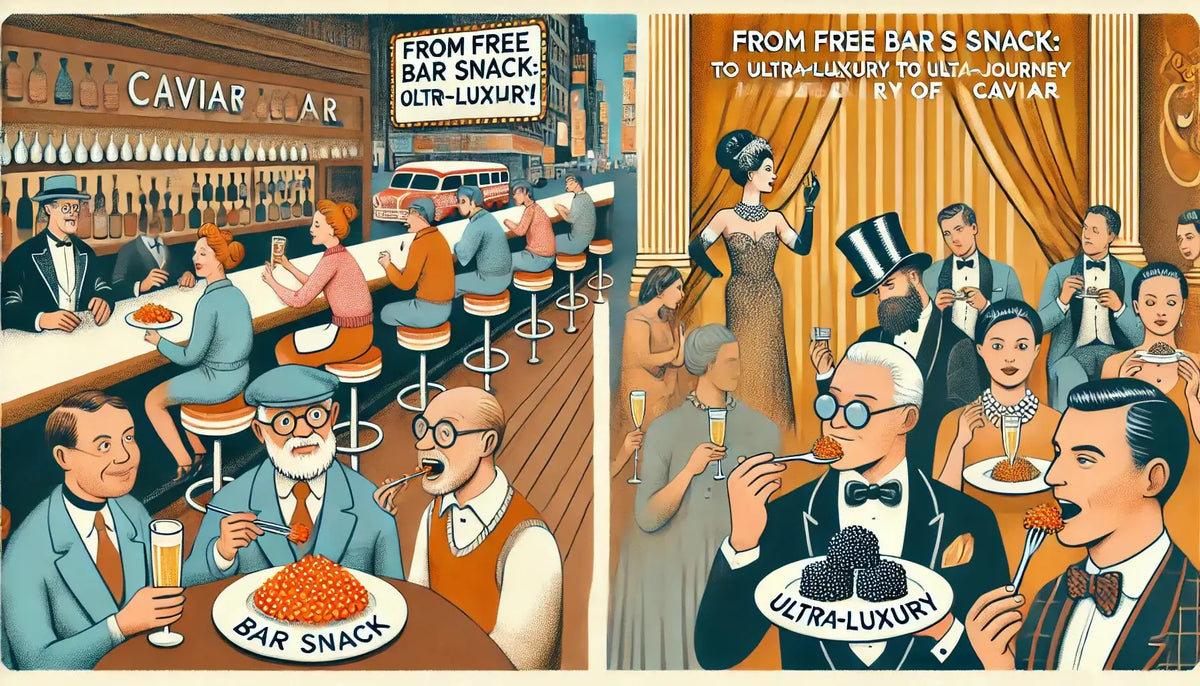
From Bar Snack to High Society Delicacy: The Unlikely Rise of Caviar in America
|
|
Time to read 4 min
|
|
Time to read 4 min
In the late 1800s, American bars served caviar to thirsty patrons in a scene that would be unrecognizable today. Little did they know, this salty snack would soon ascend to the top of the gourmet food chain.
If you walked into an American bar in the 19th century, you might have found an odd scene: alongside pints of beer and shots of whiskey, you’d see bowls of caviar—piled high and free for the taking. This now-luxury food, served without charge in the dim glow of saloon lighting, became a reliable tool for bar owners. The caviar was saltier than the Atlantic and twice as thirst-inducing. And that was exactly the point.
Back then, sturgeon filled American rivers. From New York’s Hudson to New Jersey’s Delaware, these massive fish were so common they earned the humble nickname "Albany beef." As the sturgeon population soared, so did the availability of their rich, salty roe—caviar. For bar owners, this abundant resource proved to be a strategic way to keep patrons drinking. The saltiness of the caviar made customers parched, and nothing quenched that thirst quite like a glass of ale or a shot of whiskey. At no extra cost, patrons got a taste of something exotic, and bar tabs grew longer as patrons ordered drink after drink. Little did they know that the free snack at their fingertips would one day become a coveted delicacy.
In the late 1800s, the United States was actually the world’s top producer of caviar, outpacing even the famed Russian caviar industry. By the 1870s, America exported more caviar than Russia, making it an international player in the market for this fine food. Towns like Caviar, New Jersey (yes, that’s a real place), grew as production centers. Sturgeon eggs weren’t only served in bars; they were also fed to livestock, so abundant were they in the United States.
But all this free caviar came with a cost. Sturgeon fishing was largely unregulated, and soon the massive fish populations dwindled under the weight of industrial fishing. By the early 20th century, the once-thriving sturgeon populations in the United States were in serious decline. Gone were the days of “Albany beef,” and suddenly, caviar was no longer a free snack but a costly treat. As the sturgeon vanished from American rivers, caviar’s price soared, and it transformed from a commonplace snack into a luxury item. This shift, while tragic for the environment, helped solidify caviar’s new status as a symbol of wealth and refinement.
Caviar’s popularity in Europe, particularly in Russia, further influenced American perceptions. For Russian czars, caviar was more than a food—it was a point of national pride. To the Russian elite, caviar was not only delicious but symbolic, a dish that represented their wealth, power, and influence. Russian royalty even went so far as to reserve the best caviar exclusively for the czar’s table. Over time, American society took note, and caviar slowly became associated with sophistication and exclusivity.
By the time the sturgeon population plummeted in America, caviar had become a European import, expensive and elusive. With scarcity driving up prices, high-end restaurants began to offer caviar on their menus as a mark of refinement and status. It was no longer a bar snack but a luxury item reserved for those who could afford it.
In the Soviet era, Russia and Iran became the primary producers of caviar, controlling access to what was now an international delicacy. Caviar became so valuable that an underground market emerged, especially for the highly prized Beluga caviar.
Smugglers and black-market traders trafficked in this “black gold,” making fortunes on the side. Stories circulated of caviar smuggling operations, and some shipments were as well-guarded as government secrets. In the 20th century, caviar was transformed not only into a luxury good but a symbol of illicit wealth and high-stakes drama.
Today, we rarely think of caviar as a free bar snack. Its reputation as a high-end indulgence has erased the memory of those early American bars that handed it out to make customers thirstier. But this unique journey—from common snack to luxury icon—shows us how cultural perceptions can change the value of food. What we once took for granted as commonplace can, over time, transform into something rare and precious.
Food history is filled with these transformations. Take lobster, once fed to prisoners and considered “poverty food” in the 1800s. Now, it’s a delicacy often reserved for special occasions. Caviar’s journey mirrors this arc, moving from abundance and low cost to scarcity and high esteem. Who knows what other common foods today might follow this trajectory?
While the days of free caviar in bars are long gone, the world of caviar has expanded. Modern caviar production is now global, with sustainable farms in countries like China and the United States making caviar more accessible than ever. Brands like Opus Caviar are redefining caviar for the modern age, offering high-quality, farmed sturgeon roe that lets anyone experience a taste of luxury.
The next time you find yourself savoring caviar, consider the winding path it took to get to your plate. From the bars of 19th-century America to today’s Michelin-starred tables, caviar’s journey reminds us that food is more than sustenance; it’s history, culture, and sometimes, pure chance. So raise a toast to caviar, the ultimate comeback delicacy, and enjoy every last bite of this salty, storied treasure.
$0.00 USD



